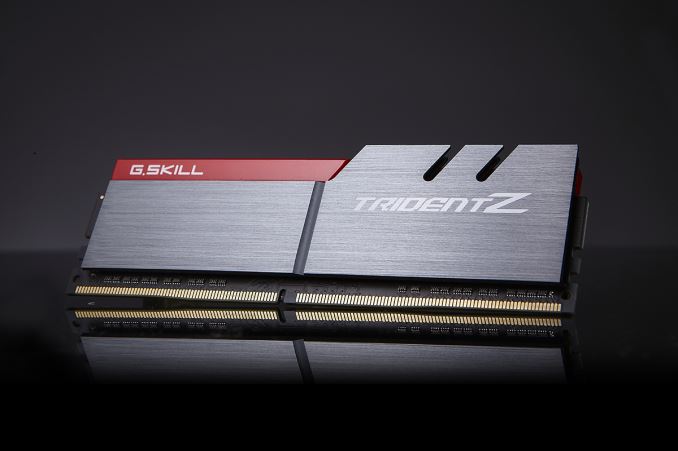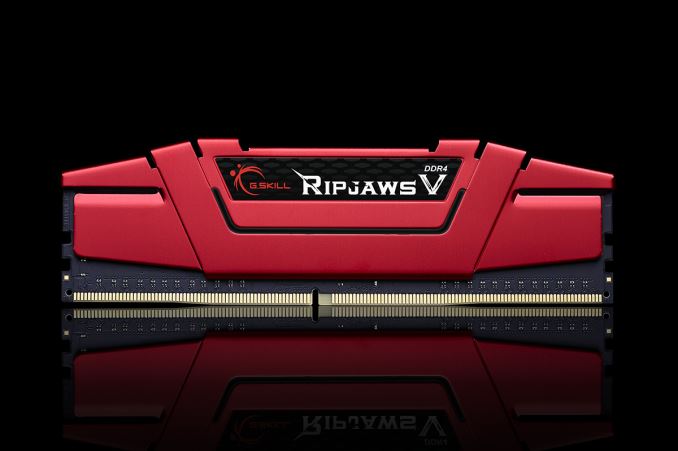G.Skill Announces DDR4-4000 and DRAM in Dual Channel Kits
by Ian Cutress on July 29, 2015 9:43 AM EST
At this point in time, the only commercial platform that runs DDR4 is the Haswell-E processor combined with the X99 chipset. For that platform, the processor has a quad-channel memory controller and in order to extract the best performance, four memory modules are needed – we published a large breakdown on the effect of the DDR4 memory speed on this platform earlier in the year.
Despite this, G.Skill is today announcing its upcoming memory kits – specifically ‘designed for 6th Gen Intel Core Processors and Z170 motherboards’, or what the rest of us calls ‘Skylake’. These new kits fall into two series called ‘Trident Z’ and ‘Ripjaws V’, with the Trident line being typically faster than Ripjaws although there will be crossover. Memory companies usually do this in order to enable users who prefer one style over the other but still want a certain speed.
These new kits, not only being announced seemingly early, also seem to break DRAM speed barriers for kits in the market. The new Skylake platform is expected to have a memory rating equivalent for the JEDEC specifications for DDR4, which is DDR4-2133 at subtimings of 15-15-15. One of the new kits pushes through to DDR4-4000, almost doubling the frequency of the JEDEC standard, although with a slightly slower sub-timings of 19-25-25.
These will be available only in 2x4 GB form, with pricing not announced. All Trident Z modules will run at the higher DDR4 voltage standard of 1.35 volts except this DDR4-4000 kit, which will require 1.35-1.40 volts. It would seem that the ICs used here are hand picked and tested, and thus each kit might have slightly different voltage requirements and thus uniquely programmed.
The other design is the Ripjaws V, which will cover most frequencies from DDR4-2133 but also in the higher capacity configurations. I am told that G.Skill is ready to deploy a number of kits with 16GB modules, affording 2x16 and 4x16 kits giving 32GB and 64GB of DRAM respectively.
Ripjaws V will be available in red, blue, silver, gray and black. The 16GB modules are specifically using Samsung ICs, and will be available up to DDR4-3200.
The Trident Z line is a lot less spiky than the previous Trident modules for good reason - personally I obtained injuries using it over the years because it was simply sharp. The new line avoids this, but also enables G.Skill to add its name to the top of the module, allowing modders to indicate exactly what modules are being used.
Given this press release today, and what we’ve heard on the grapevine, it seems that Skylake is promising to be a super platform for DRAM in terms of both capacity and speed. Needless to say, pricing and specific release dates were not provided. I suspect other companies will follow with their dual channel kit announcements soon given this release today.
Source: G.Skill




















25 Comments
View All Comments
RaistlinZ - Wednesday, July 29, 2015 - link
Probably better off with tighter timings and lower clocks. The price of these DIMMS seems to increase exponentially the higher the timings, even though the performance remains almost the same.Xenonite - Thursday, July 30, 2015 - link
Actually, the time it takes to get a single transfer from RAM (i.e. the latency from the point the command and address are issued until the transferred data resides in the applicable CPU register) is roughly constant.Reducing it by any significant margin would simply be unacceptable, since a higher voltage would be required due to the long bus lines that need to be reliably driven at high speeds, which would, in turn, result in about 5~10W increased power for a 20-30% reduced latency (why 10W of extra power is so unfathomly huge is beyond me though).
However, the increased transfer rate (even with looser timings keeping the total latency constant) normally results in an overall increase in available bandwidth, due to the way the CPU caches and pipelines data and instructions.
You can think of it this way, lets say you have a 1km length of single-lane road with a 10km/h speed limit. The minimum time it takes a single car to move from the starting point to the end would then be 6 minutes (aka. the latency). However, this does NOT mean that the maximum throughput is limited to 10 cars per hour (the total bandwidth). If we were to release one car every second, which is (greatly simplified) analogous to the transfer rate of the memory module in Hz, then the total throughput would be 60 cars per hour.
In reality, you need to wait for the data on the line to be stable and latched into a register (normally a flip-flop) before you can send another piece of data (you cannot have multiple bits travelling down the same piece of uninterrupted wire), but the general idea is the same.
Unfortunately, the CPU needs to have a very effective caching algorithm (together with accurate branch prediction and instruction reordering) to hide the increased timing latencies, which is why we only see performance improving with certain workloads and only up to a certain point.
MapRef41N93W - Wednesday, July 29, 2015 - link
DDR4-4000 already? Man I can't wait to see how fast speeds are going to be when Skylake-E releases next year.Oxford Guy - Wednesday, July 29, 2015 - link
We'll see how much the latency slows them down.nandnandnand - Wednesday, July 29, 2015 - link
16 GB per module DDR4-3400. Good to see a "mainstream" higher module capacity.Impulses - Wednesday, July 29, 2015 - link
Those new Ripjaw spreaders look a lot classier than the old ones, the Trident ones look ever better. Hopefully they're making new kits available by the time Skylake is available...Right now there's somewhat of a lack of 2x8GB kits at Newegg, specially if you're trying to avoid red and stick to modestly priced 2400 stuff... There's the Ballistix, Corsair Vengeance in black, and I think a 4x8GB Corsair in blue.
I might actually end up buying that last kit and selling two of the 8GB DIMMs for $110 or whatever just to get some blue ones to match my cooler. :p
LordanSS - Wednesday, July 29, 2015 - link
Indeed... I wonder what the timings are on that part tho. If they're around 18, that'd sweeten the pot.Oxford Guy - Wednesday, July 29, 2015 - link
19-25-25etamin - Wednesday, July 29, 2015 - link
Haven't read the article yet, but the Trident Z is the first DIMM I've seen whos design alone makes me want it hahaImpulses - Wednesday, July 29, 2015 - link
Funny thing is, it's probably one of the cheapest spreaders to stamp/produce across all brands... Sometimes simple works. I'd take the old clipped on spreaders over much of the over designed ones today.